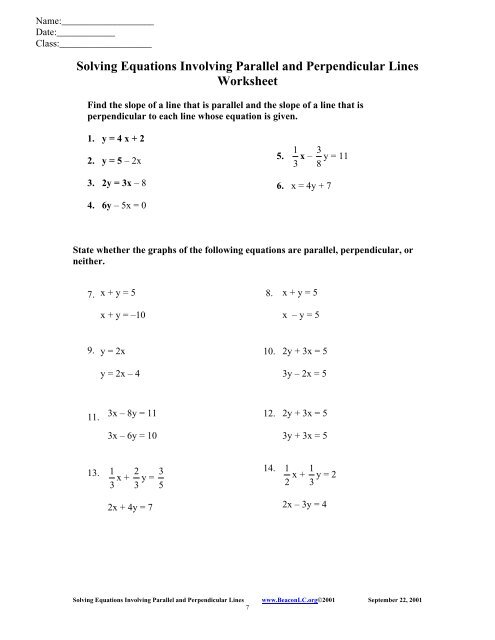Solving equations involving parallel and perpendicular lines examples
Solving equations involving parallel and perpendicular lines examples Solving equations involving parallel and perpendicular lines examples
15. Example – Find an equation of a line that passes through (5, –2) and is perpendicular 4x + 3y = 12. y = 4 − x + 4 The slope of the given line is 3 4 − (m) = –1 3 3 m = 4 4 − . 3 Let m stand for the slope of the perpendicular line. Use (5, –2) and the slope 4 3 to find the y-intercept. y = mx + b –2 = ( 4 3 )(5) + b 23 − = b 4 The y-intercept is 3 23 An equation of the line is y = x − 4 4 23 − . 4 This could be written 3x – 3y = 23 16. Thought Provoker – Is it possible that two lines represented by 6x – 4y = 2 and 2x + 3y = 7 are perpendicular? Rewrite in slope-intercept form. 6x – 4y = 2 –4y = –6x + 2 y = 2 3 x + 2 1 2x + 3y = 7 3y = –2x + 7 2 7 y = − x + 3 3 Yes. They are perpendicular. Solving Equations Involving Parallel and Perpendicular Lines www.BeaconLC.org©2001 September 22, 2001 6
Name:___________________ Date:____________ Class:___________________ Solving Equations Involving Parallel and Perpendicular Lines Worksheet Find the slope of a line that is parallel and the slope of a line that is perpendicular to each line whose equation is given. 1. y = 4 x + 2 2. y = 5 – 2x 5. 1 3 x – y = 11 3 8 3. 2y = 3x – 8 6. x = 4y + 7 4. 6y – 5x = 0 State whether the graphs of the following equations are parallel, perpendicular, or neither. 7. x + y = 5 8. x + y = 5 x + y = –10 x – y = 5 9. y = 2x 10. 2y + 3x = 5 y = 2x – 4 3y – 2x = 5 11. 3x – 8y = 11 3x – 6y = 10 12. 2y + 3x = 5 3y + 3x = 5 13. 1 2 3 x + y = 3 3 5 14. 1 1 x + y = 2 2 3 2x + 4y = 7 2x – 3y = 4 Solving Equations Involving Parallel and Perpendicular Lines www.BeaconLC.org©2001 September 22, 2001 7
- Page 1 and 2: Solving Equations Involving Paralle
- Page 3 and 4: 7. Example - Find an equation of th
- Page 5: 13. Example - Find an equation of t
- Page 9 and 10: Name:___________________ Date:_____
- Page 11 and 12: Find an equation of the line that p
- Page 13 and 14: 22. (12, 6); 4 3 x + 2 1 y = 2 3 1
- Page 15 and 16: Student Name: __________________ Da
Name:___________________<br />
Date:____________<br />
Class:___________________<br />
<strong>Solving</strong> Equations Involving Parallel <strong>and</strong> Perpendicular Lines<br />
Worksheet<br />
Find the slope of a line that is <strong>parallel</strong> <strong>and</strong> the slope of a line that is<br />
<strong>perpendicular</strong> to each line whose equation is given.<br />
1. y = 4 x + 2<br />
2. y = 5 – 2x<br />
5.<br />
1 3 x – y = 11<br />
3 8<br />
3. 2y = 3x – 8<br />
6. x = 4y + 7<br />
4. 6y – 5x = 0<br />
State whether the graphs of the following <strong>equations</strong> are <strong>parallel</strong>, <strong>perpendicular</strong>, or<br />
neither.<br />
7.<br />
x + y = 5<br />
8.<br />
x + y = 5<br />
x + y = –10<br />
x – y = 5<br />
9.<br />
y = 2x<br />
10.<br />
2y + 3x = 5<br />
y = 2x – 4<br />
3y – 2x = 5<br />
11.<br />
3x – 8y = 11<br />
3x – 6y = 10<br />
12. 2y + 3x = 5<br />
3y + 3x = 5<br />
13.<br />
1 2 3 x + y =<br />
3 3 5<br />
14.<br />
1 1 x + y = 2<br />
2 3<br />
2x + 4y = 7<br />
2x – 3y = 4<br />
<strong>Solving</strong> Equations Involving Parallel <strong>and</strong> Perpendicular Lines www.BeaconLC.org©2001 September 22, 2001<br />
7



